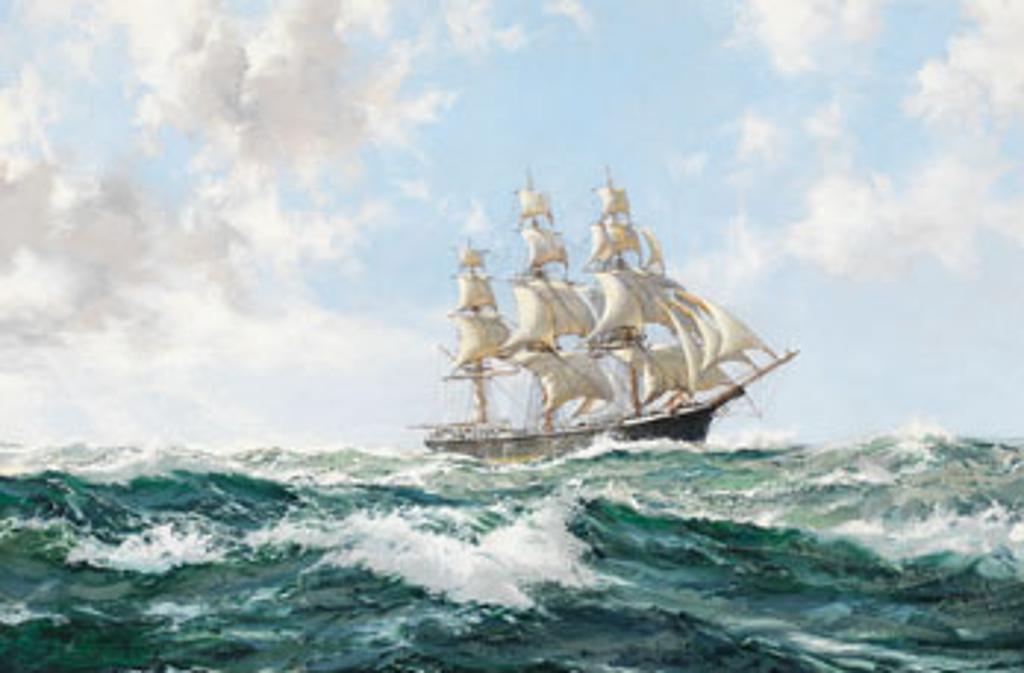
The Flying Cloud
50.8 cms x 76.2 cms (20 ins x 30 ins)
Signed and on verso titled on the gallery label and stamped made in england
Lot offered for sale by Heffel, Vancouver at the auction event "October 2017 Online auction" held on Thu, Oct 26, 2017.
Lot 304
Lot 304
Estimate: CAD $50,000 - $75,000
Realised: CAD $55,250
Realised: CAD $55,250
Lot description - from the online catalogue*
Provenance:
Watson Art Galleries, Montreal
By descent to the present Private Collection, Toronto
Notes:
Montague Dawson was one of the preeminent maritime artists of the twentieth century, which is reflected by the inclusion of his works in the collections of the Royal Naval Museum in Portsmouth and the National Maritime Museum in Greenwich. The artist’s prominence is made even more extraordinary as he never received any formal art training. Dawson began drawing as a young child and honed his illustration skills in 1910 at a commercial art studio. His attention to technical detail and his highly realistic style created a strong demand for his seascapes. While occasionally depicting ships from the late seventeenth century, Dawson was best known for his depictions of nineteenth century clipper ships.
The Flying Cloud, one of the distinguished American extreme clippers, was built by Donald McKay in 1851 in East Boston and bought by Grinnell, Minturn & Co. of New York for $90,000. Within six weeks of her launch, The Flying Cloud ran the New York to San Francisco trade route via Cape Horn and on her maiden voyage set a record speed on the route. The voyage usually took more than 200 days to cover 16,000 miles, and The Flying Cloud then bested this on her fourth voyage. She set the world record at 89 days and 8 hours, anchor to anchor, which was a record that stood for 136 years. While the record performance was significant in and of itself, it was even more unique because the navigator was a woman, Eleanor Cressey. Cressey was one of the first navigators to use the course recommended by Matthew Fontaine Maury, the father of modern oceanography, in his Sailing Directions. Due to a lack of cargo, the clipper was out of commission for over two years before being sold to new owners in 1859. Thereafter, she traded out of London, including one tea voyage in 1860 and a charter to return troops home from Hong Kong in 1861 to 1862. In her final years, The Flying Cloud was involved in the timber trade before being wrecked in 1874 on Beacon Island bar, outside St. John’s, Newfoundland.
In The Flying Cloud, Dawson captures the speed for which extreme clippers were known through his realistic portrayal of the cresting, choppy waves and billowing sails. The Flying Cloud typifies Dawson’s attention to detail, right down to the minutia of the crew aboard the deck of the ship.
Watson Art Galleries, Montreal
By descent to the present Private Collection, Toronto
Notes:
Montague Dawson was one of the preeminent maritime artists of the twentieth century, which is reflected by the inclusion of his works in the collections of the Royal Naval Museum in Portsmouth and the National Maritime Museum in Greenwich. The artist’s prominence is made even more extraordinary as he never received any formal art training. Dawson began drawing as a young child and honed his illustration skills in 1910 at a commercial art studio. His attention to technical detail and his highly realistic style created a strong demand for his seascapes. While occasionally depicting ships from the late seventeenth century, Dawson was best known for his depictions of nineteenth century clipper ships.
The Flying Cloud, one of the distinguished American extreme clippers, was built by Donald McKay in 1851 in East Boston and bought by Grinnell, Minturn & Co. of New York for $90,000. Within six weeks of her launch, The Flying Cloud ran the New York to San Francisco trade route via Cape Horn and on her maiden voyage set a record speed on the route. The voyage usually took more than 200 days to cover 16,000 miles, and The Flying Cloud then bested this on her fourth voyage. She set the world record at 89 days and 8 hours, anchor to anchor, which was a record that stood for 136 years. While the record performance was significant in and of itself, it was even more unique because the navigator was a woman, Eleanor Cressey. Cressey was one of the first navigators to use the course recommended by Matthew Fontaine Maury, the father of modern oceanography, in his Sailing Directions. Due to a lack of cargo, the clipper was out of commission for over two years before being sold to new owners in 1859. Thereafter, she traded out of London, including one tea voyage in 1860 and a charter to return troops home from Hong Kong in 1861 to 1862. In her final years, The Flying Cloud was involved in the timber trade before being wrecked in 1874 on Beacon Island bar, outside St. John’s, Newfoundland.
In The Flying Cloud, Dawson captures the speed for which extreme clippers were known through his realistic portrayal of the cresting, choppy waves and billowing sails. The Flying Cloud typifies Dawson’s attention to detail, right down to the minutia of the crew aboard the deck of the ship.
Most realised prices include the Buyer's Premium of 18-25%, but not the HST/GST Tax.
(*) Text and/or Image might be subject matter of Copyright. Check with Heffel auction house for permission to use.
(*) Text and/or Image might be subject matter of Copyright. Check with Heffel auction house for permission to use.